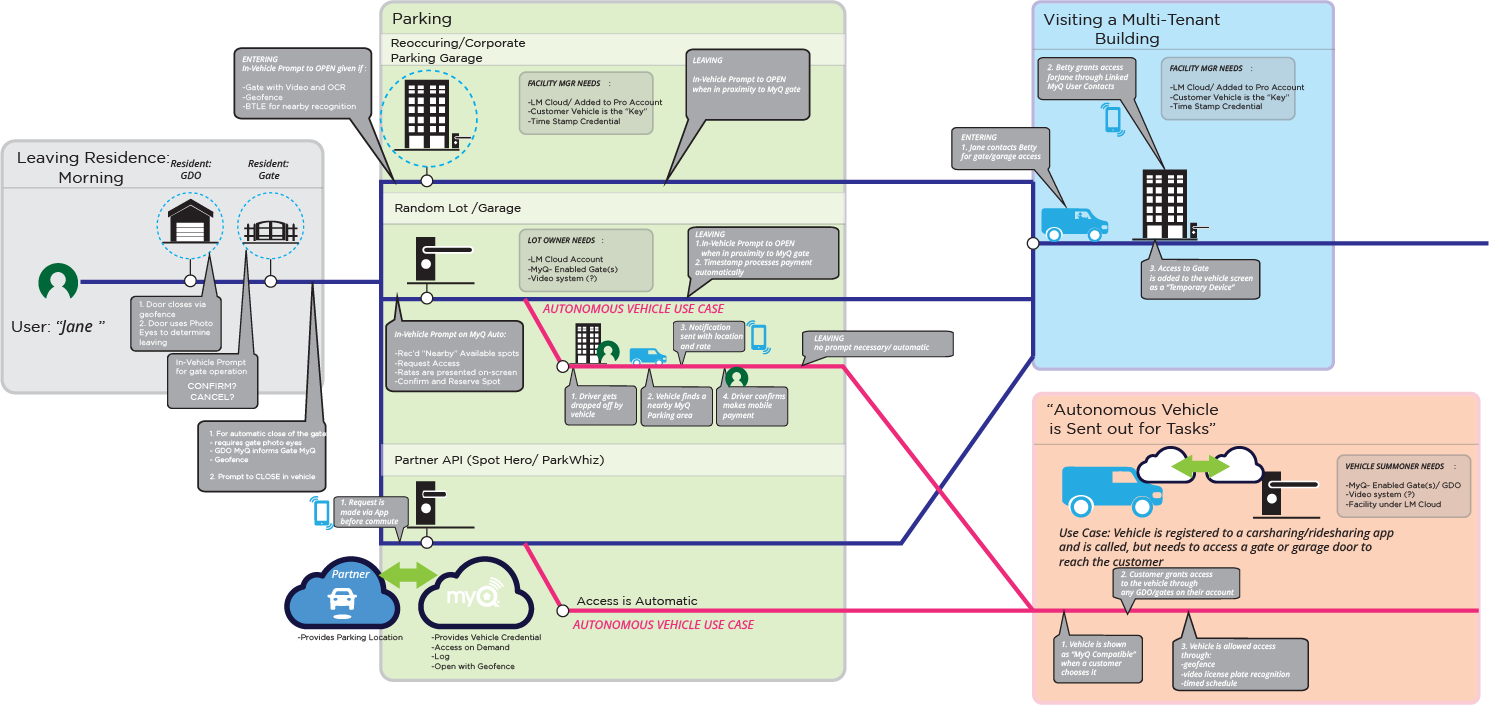Vehicle Infotainment Smart Home Control
ROLE:
UIUX Design, UX research, Visual Design and standards.
Collaboration with hardware, firmware and software development.
As more vehicles add connectivity to their infotainment system, the connection between car and home becomes more desirable.
PROGRAM GOALS
MyQ Auto provides seamless access through residential garage doors, commercial gates, parking services, and allows user to set up automated scenes within their smart home
With the growth of ride-sharing apps and autonomous vehicles, the ability to provide seamless credentialing is key to a positive user experience.
CHALLENGES + PAIN POINTS
How to leverage traditional interaction behaviors within the vehicle while adding complex information
Creating a setup flow that is intuitive and empowering
Providing additional expansion for new use cases
Designing consistency across mobile apps and in-vehicle displays
EARLY RESEARCH AND JOURNEY MAPS
Early mockups and prototypes were created by the team to describe the vision for MyQ Auto. As the amount of use cases and applications grew, these early layouts proved to be too complex and confusing for the user. The team needed to look at the connected vehicle ecosystem and develop new journey maps.
As autonomous use cases such as self-park and delivery take form, additional user journeys and device journeys need to be mapped in order to ensure integration along all access points.
INITIAL WIREFRAMES/ MOCKUPS FOR GENERAL MOTORS SOFTWARE DEV. KIT
Initial mockup and prototype was built for an opportunity with General Motors.
Specific design intent and layout needed to be followed due to software parameters, but this lead to a reduction in visual noise and a renewed focus on clear presentation of the main user flows.
USE CASE FOCUS
User Log-in from the touchscreen
Notifications and On-Screen Messaging
Current device status and control
UMTRI COMPLIANCE REVIEW + PROTOYPE CHANGES
Consulting with the Transportation Research Institute from the University of Michigan created a new set of parameters for in-vehicle touchscreen design. Early prototypes were examined by the UMTRI leads, and guidelines were given in order to maintain government quality and safety standards
Reduce Level of Driver Distraction
-Appropriate colors and contrast
-Minimize “Glance time”
-Size of type and interaction points
Decrease Cognitive Load to the Driver
-Simplify presentation
-Do not introduce time-based interaction
-Lock some features while driving
Consider Environmental Factors
-Day vs. Night driving
-Level of feedback in warning protocols
-Additional feedback through auditory signals
Prototypes for Usability Research
Working prototypes were developed for a moderated usability study. Focus was given to 1) driver control of devices and device status 2) checking device status and operating during driving and 3) receiving notifications of door status with required feedback.
USABILTY STUDY- INVEHICLE EXPERIENCE
User research was a moderated usability study, where 16 users were interviewed and asked to run through basic actions on a working app prototype. To simulate real-world situations ,the users were asked to be in a vehicle in a controlled situation. Depending on the task involved, automated messages and notifications were added to interrupt.
The study was conducted over 4 days, in Chicago and Denver.
Josh, Denver:
“The thing about this is that instead of 4 clicks on the phone, I can get the status in one click, I like that..”
Karen, Denver:
“This makes me feel a little more secure, I feel like I don’t have to take my eyes off the road..”
Daisy, Chicago:
“I like this because I believe that anything that takes your eyes off the road…is a big problem..”
Joseph, Chicago:
“It’s just easier, it’s all right there, and if I can set it to automatically open?, even better..”
Preparing Mockup screens for Android Auto
To increase adoption and maximize platform reach, development for MyQ Auto was shifted toward Android Auto integration. Previous learnings were incorporated, along with a card-system for devices shown on the main screen. Tasks such as “Creating Scenes” and “Managing Vehicles” were shifted toward the mobile phone app. The intent was to create a consistent experience across all devices.
Main in-vehicle screens and Menu items
In-app mobile sign-in
Main Categories: Devices, Places, Vehicles
Creating a new Automated Scene and trigger from connected Smart Home devices integrated through the app API
OUTPUTS AND KEY FINDINGS
MyQ Auto was explored as a template for OEMs to use for experience design. The goal was to handoff the structure and have each manufacturer add specific details related to their brand. By gathering relevant user research and A-B testing iterations of icons, placement and message, OEMs were provided a plug-and-play option for their OS.
Currently available on Mitsubishi and Tesla automobiles.

























